Comparison of Satellite-Based and Ångström–Prescott Estimated Global Horizontal Irradiance under Different Cloud Cover Conditions in South African Locations
Abstract
1. Introduction
2. Materials and Methods
2.1. Observation GHI Datasets
2.2. Satellite-Based Datasets
2.3. Ångström–Prescott (AP) Model
2.4. Study Method
2.5. Control of Observation Data
2.6. Clear-Sky and Cloud-Sky Determination
2.7. Quantitative Assessment
2.8. Most Viable Estimated Dataset with Relative Rating per Station
2.9. Quantifying the Impact of Cloud Coverage on Dataset Performance
3. Results and Discussions
3.1. All-Sky Cloud Condition Results
3.1.1. Copernicus Atmosphere Monitoring Service (CAMS)
- %;
- ;
- and
- .
3.1.2. Satellite Application Facility on Climate Monitoring (CMSAF)
- ;
- ;
- and
- .
3.1.3. SOLCAST
- %;
- ;
- and
3.1.4. Ångström–Prescott (AP) Model
- ;
- and
- .
3.1.5. NASA SSE
- %;
- ;
- and
- .
3.2. Clear-Sky Conditions Results
3.3. Overcast-Sky Conditions Results
3.4. Clear-Sky versus Overcast-Sky Conditions
4. Discussion
4.1. All-Sky Conditions
4.2. Clear-Sky, All-Sky, and Clear-Sky Conditions
5. Conclusions
Author Contributions
Funding
Institutional Review Board Statement
Informed Consent Statement
Acknowledgments
Conflicts of Interest
References
- Duffie, J.A.; Beckman, W.A.; Blair, N. Solar Engineering of Thermal Processes, Photovoltaics and Wind; John Wiley & Sons: Hoboken, NJ, USA, 2020. [Google Scholar]
- Iqbal, M. An Introduction to Solar Radiation; Elsevier: Amsterdam, The Netherlands, 2012. [Google Scholar]
- Foster, R.; Ghassemi, M.; Cota, A. Solar Energy: Renewable Energy and the Environment; CRC Press: Boca Raton, FL, USA, 2009. [Google Scholar]
- Sen, Z. Solar Energy Fundamentals and Modeling Techniques: Atmosphere, Environment, Climate Change and Renewable Energy; Springer Science & Business Media: Berlin/Heidelberg, Germany, 2008. [Google Scholar]
- Kalogirou, S.A. Solar Energy Engineering: Processes and Systems; Academic Press: Cambridge, MA, USA, 2013. [Google Scholar]
- Wald, L. Basics in Solar Radiation at Earth Surface. 2018. Available online: https://hal-minesparistech.archives-ouvertes.fr/hal-01676634 (accessed on 15 February 2021).
- Schwandt, M.; Chhatbar, K.; Meyer, R.; Mitra, I.; Vashistha, R.; Giridhar, G.; Gomathinayagam, S.; Kumar, A. Quality check procedures and statistics for the Indian SRRA solar radiation measurement network. Energy Procedia 2014, 57, 1227–1236. [Google Scholar] [CrossRef]
- Zawilska, E.; Brooks, M. An assessment of the solar resource for Durban, South Africa. Renew. Energy 2011, 36, 3433–3438. [Google Scholar] [CrossRef]
- Urraca, R.; Gracia-Amillo, A.M.; Huld, T.; Martinez-De-Pison, F.J.; Trentmann, J.; Lindfors, A.V.; Riihelä, A.; Sanz-Garcia, A. Quality control of global solar radiation data with satellite-based products. Sol. Energy 2017, 158, 49–62. [Google Scholar] [CrossRef]
- Zawilska, E.; Brooks, M.J.; Meyer, A.J. A review of solar resource assessment initiatives in South Africa: The case for a national network. In Proceedings of the World Renewable Energy Forum, Denver, CO, USA, 13–17 May 2012. [Google Scholar]
- Jiang, H.; Yang, Y.; Bai, Y.; Wang, H. Evaluation of the total, direct, and diffuse solar radiations from the ERA5 reanalysis data in China. IEEE Geosci. Remote Sens. Lett. 2020, 17, 47–51. [Google Scholar] [CrossRef]
- Sianturi, Y.; Marjuki; Sartika, K. Evaluation of ERA5 and MERRA2 reanalyses to estimate solar irradiance using ground observations over Indonesia region. AIP Conf. Proc. 2020, 2223, 020002. [Google Scholar]
- Tang, W.; Yang, K.; He, J.; Qin, J. Quality control and estimation of global solar radiation in China. Sol. Energy 2010, 84, 466–475. [Google Scholar] [CrossRef]
- Zhang, Q.; Cui, N.; Feng, Y.; Jia, Y.; Li, Z.; Gong, D. Comparative Analysis of Global Solar Radiation Models in Different Regions of China. Adv. Meteorol. 2018, 2018, 3894831. [Google Scholar] [CrossRef]
- Almorox, J.; Benito, M.; Hontoria, C. Estimation of monthly Angström-Prescott equation coefficients from measured daily data in Toledo, Spain. Renew. Energy 2005, 30, 931–936. [Google Scholar] [CrossRef]
- Adamala, S.; Reddy, Y.V.K. Evaluation of Different Solar Radiation Estimation Methods for Indian Locations. In Water Resources and Environmental Engineering II; Springer: Berlin/Heidelberg, Germany, 2018; pp. 47–56. [Google Scholar]
- De Medeiros, F.J.; Silva, C.M.; Bezerra, B.G. Calibration of Ångström-Prescott Equation to Estimate Daily Solar Radiation on Rio Grande do Norte State, Brazil. Rev. Bras. Meteorol. 2017, 32, 409–416. [Google Scholar] [CrossRef][Green Version]
- Marchand, M.; Ghennioui, A.; Wey, E.; Wald, L. Comparison of several satellite-derived databases of surface solar radiation against ground measurement in Morocco. Adv. Sci. Res. 2018, 15, 21–29. [Google Scholar] [CrossRef]
- Martín-Pomares, L.; Romeo, M.G.; Polo, J.; Frías-Paredes, L.; Fernández-Peruchena, C.M. Sampling design optimization of ground radiometric stations. In Solar Resources Mapping; Springer International Publishing: Cham, Switzerland, 2019; pp. 253–281. [Google Scholar]
- Wilbert, S.; Stoffel, T.; Myers, D.; Wilcox, S.; Habte, A.; Vignola, F.; Wood, J.; Pomares, L.M. Measuring Solar Radiation and Relevant Atmospheric Parameters. In Best Practices Handbook for the Collection and Use of Solar Resource Data for Solar Energy Applications; National Renewable Energy Laboratory: Golden, CO, USA, 2017. Available online: https://hal-mines-paristech.archives-ouvertes.fr/hal-01184753 (accessed on 12 March 2020).
- Moradi, I. Quality control of global solar radiation using sunshine duration hours. Energy 2009, 34, 1–6. [Google Scholar] [CrossRef]
- Garg, H.P.; Garg, S.N. Measurement of solar radiation—II. Calibration and standardization. Renew. Energy 1993, 3, 335–348. [Google Scholar] [CrossRef]
- Žák, M.; Mikšovský, J.; Pišoft, P. CMSAF radiation data: New possibilities for climatological applications in the Czech Re-public. Remote Sens. 2015, 7, 14445–14457. [Google Scholar] [CrossRef]
- Angstrom, A. Solar and terrestrial radiation: Report to the international commission for solar research on actinometric investigations of solar and atmospheric radiation. Quart. J. Roy. Meteorol. Soc. 1924, 50, 121–126. [Google Scholar] [CrossRef]
- Prescott, J.A. Evaporation from a water surface in relation to solar radiation. Trans. Roy. Soc. S. Aust. 1940, 46, 114–118. [Google Scholar]
- Mabasa, B.; Lysko, M.D.; Tazvinga, H.; Mulaudzi, S.T.; Zwane, N.; Moloi, S.J. The Ångström–Prescott Regression Coefficients for Six Climatic Zones in South Africa. Energies 2020, 13, 5418. [Google Scholar] [CrossRef]
- SOLCAST. Available online: https://solcast.com (accessed on 7 April 2022).
- SOLCAST Historical Data Validation. Available online: https://solcast.com/historical-and-tmy/validation-and-accuracy (accessed on 7 April 2022).
- Copernicus Portal. Available online: https://atmosphere.copernicus.eu/data (accessed on 26 March 2022).
- Solar Radiation Data (SoDa) Service. Available online: http://solar.atmosphere.copernicus.eu/cams-radiation-service (accessed on 2 March 2022).
- Qu, Z.; Oumbe, A.; Blanc, P.; Espinar, B.; Gesell, G.; Gschwind, B.; Klüser, L.; Lefèvre, M.; Saboret, L.; Schroedter-Homscheidt, M.; et al. Fast radiative transfer parameterisation for assessing the surface solar irradiance: The Heliosat-4 method. Meteorol. Z. 2017, 26, 33–57. [Google Scholar] [CrossRef]
- Pfeifroth, U.; Kothe, S.; Trentmann, J.; Hollmann, R.; Fuchs, P.; Kaiser, J.; Werscheck, M. Surface Radiation Data Set—Heliosat (SARAH), 2nd ed.; Satellite Application Facility on Climate Monitoring: Offenbach, Germany, 2019; Available online: https://www.cmsaf.eu/SharedDocs/Literatur/document/2016/saf_cm_dwd_val_meteosat_hel_2_1_pdf.pdf?__blob=publicationFile (accessed on 17 February 2022).
- Mabasa, B.; Lysko, M.D.; Moloi, S.J. Validating Hourly Satellite Based and Reanalysis Based Global Horizontal Irradiance Datasets over South Africa. Geomatics 2021, 1, 429–449. [Google Scholar] [CrossRef]
- Hersbach, H.; Bell, B.; Berrisford, P.; Hirahara, S.; Horányi, A.; Muñoz-Sabater, J.; Nicolas, J.; Peubey, C.; Radu, R.; Schepers, D.; et al. The ERA5 Global Reanalysis. Q. J. R. Meteorol. Soc. 2020, 146, 1999–2049. [Google Scholar] [CrossRef]
- Gelaro, R.; McCarty, W.; Suárez, M.J.; Todling, R.; Molod, A.; Takacs, L.; Randles, C.A.; Darmenov, A.; Bosilovich, M.G.; Reichle, R.; et al. The Modern-Era Retrospective Analysis for Research and Applications, Version 2 (MERRA-2). J. Clim. 2017, 30, 5419–5454. [Google Scholar] [CrossRef]
- NASA SSE. These Data Were Obtained from the NASA Langley Research Center (LaRC) POWER Project Funded through the NASA Earth Sci-ence/Applied Science Program. Available online: https://power.larc.nasa.gov/data-access-viewer/ (accessed on 2 February 2020).
- Mabasa, B.; Lysko, M.D.; Tazvinga, H.; Zwane, N.; Moloi, S.J. The Performance Assessment of Six Global Horizontal Irradiance Clear Sky Models in Six Climatological Regions in South Africa. Energies 2021, 14, 2583. [Google Scholar] [CrossRef]
- Long, C.N.; Dutton, E.G. BSRN Global Network Recommended QC Tests, V2. 2010. Available online: https://epic.awi.de/30083/1/BSRN_recommended_QC_tests_V2.pdf (accessed on 11 March 2022).
- Roesch, A.; Wild, M.; Ohmura, A.; Dutton, E.G.; Long, C.N.; Zhang, T. Assessment of BSRN radiation records for the computation of monthly means. Atmos. Meas. Tech. 2011, 4, 339–354. [Google Scholar] [CrossRef]
- Driemel, A.; Augustine, J.; Behrens, K.; Colle, S.; Cox, C.; Cuevas-Agulló, E.; Denn, F.M.; Duprat, T.; Fukuda, M.; Grobe, H.; et al. Baseline Surface Radiation Network (BSRN): Structure and data description (1992–2017). Earth Syst. Sci. Data 2018, 10, 1491–1501. [Google Scholar] [CrossRef]
- Geiger, M.; Diabaté, L.; Ménard, L.; Wald, L. A web service for controlling the quality of measurements of global solar irradiation. Sol. Energy 2002, 73, 475–480. [Google Scholar] [CrossRef]
- Finkensieper, S.; Stengel, M.; Selbach, N.; Rainer, H.; Werscheck, M.; Meirink, J.F. ICDR SEVIRI Clouds—Based on CLAAS-2 Methods, Satellite Application Facility on Climate Monitoring. Available online: https://wui.cmsaf.eu/safira/action/viewICDRDetails?acronym=CLAAS_V002_ICDR (accessed on 2 February 2021).
- Benas, N.; Finkensieper, S.; Stengel, M.; van Zadelhoff, G.-J.; Hanschmann, T.; Hollmann, R.; Meirink, J.F. The MSG-SEVIRI-based cloud property data record CLAAS-2. Earth Syst. Sci. Data 2017, 9, 415–434. [Google Scholar] [CrossRef]
- Tuononen, M.; O’Connor, E.J.; Sinclair, V.A. Evaluating solar radiation forecast uncertainty. Atmos. Chem. Phys. 2019, 19, 1985–2000. [Google Scholar] [CrossRef]
- Cloud Coverage in South Africa (Mini-Project). Available online: https://www.cmsaf.eu/EN/Products/Tools/R/Monthly_Report_Cloud_Coverage_pdf.pdf?__blob=publicationFile&v=2 (accessed on 2 December 2021).
- Gueymard, C.A. A review of validation methodologies and statistical performance indicators for modeled solar radiation data: Towards a better bankability of solar projects. Renew. Sustain. Energy Rev. 2014, 39, 1024–1034. [Google Scholar] [CrossRef]
- Carlos, M.; Peruchena, F.; Martín Gastón, M. A simple and efficient procedure for increasing the temporal resolution of global horizontal solar irradiance series. Renew. Energy 2016, 86, 375–383. [Google Scholar] [CrossRef]
- Marchand, M.; Lefèvre, M.; Saboret, L.; Wey, E.; Wald, L. Verifying the spatial consistency of the CAMS Radiation Service and HelioClim-3 satellite-derived databases of solar radiation using a dense network of measuring stations: The case of The Netherlands. Adv. Sci. Res. 2019, 16, 103–111. [Google Scholar] [CrossRef]
- Marchand, M.; Saint-Drenan, Y.M.; Saboret, L.; Wey, E.; Wald, L. Performance of CAMS Radiation Service and HelioClim-3 databases of solar radiation at surface: Evaluating the spatial variation in Germany. Adv. Sci. Res. 2020, 17, 143–152. [Google Scholar] [CrossRef]
- Trolliet, M.; Walawender, J.P.; Bourlès, B.; Boilley, A.; Trentmann, J.; Blanc, P.; Lefèvre, M.; Wald, L. Downwelling surface solar irradiance in the tropical Atlantic Ocean: A comparison of re-analyses and satellite-derived data sets to PIRATA measurements. Ocean Sci. 2018, 14, 1021–1056. [Google Scholar] [CrossRef]
- Gueymard, C.A. REST2: High-performance solar radiation model for cloudless-sky irradiance, illuminance, and photosyntheti-cally active radiation—Validation with a benchmark dataset. Sol. Energy 2008, 82, 272–285. [Google Scholar] [CrossRef]
- Sun, X.; Bright, J.M.; Gueymard, C.A.; Acord, B.; Wang, P.; Engerer, N.A. Worldwide performance assessment of 75 global clear-sky irradiance models using principal component analysis. Renew. Sustain. Energy Rev. 2019, 111, 550–570. [Google Scholar] [CrossRef]
- Urraca, R.; Gracia-Amillo, A.M.; Koubli, E.; Huld, T.; Trentmann, J.; Riihelä, A.; Lindfors, A.V.; Palmer, D.; Gottschalg, R.; Antonanzas-Torres, F. Extensive validation of CM SAF surface radiation products over Europe. Remote Sens. Environ. 2017, 199, 171–186. [Google Scholar] [CrossRef]
- Mueller, R.W.; Matsoukas, C.; Gratzki, A.; Behr, H.D.; Hollmann, R. The CM-SAF operational scheme for the satellite based retrieval of solar surface irradiance—A LUT based eigenvector hybrid approach. Remote Sens. Environ. 2009, 113, 1012–1024. [Google Scholar] [CrossRef]
- Neher, I.; Crewell, S.; Meilinger, S.; Pfeifroth, U.; Trentmann, J. Photovoltaic power potential in West Africa using long-term satellite data. Atmos. Chem. Phys. 2020, 20, 12871–12888. [Google Scholar] [CrossRef]
- Jed, M.; Ihaddadene, N.; Jed, M.E.; Ihaddadene, R.; El Bah, M. Validation of the Accuracy of NASA Solar Irradiation Data for Four African Regions. Planning 2022, 17, 29–39. [Google Scholar] [CrossRef]
- Lefèvre, M.; Oumbe, A.; Blanc, P.; Espinar, B.; Gschwind, B.; Qu, Z.; Wald, L.; Schroedter-Homscheidt, M.; Hoyer-Klick, C.; Arola, A.; et al. McClear: A new model estimating downwelling solar radiation at ground level in clear-sky conditions. Atmos. Meas. Tech. 2013, 6, 2403–2418. [Google Scholar] [CrossRef]
- Thomas, C.; Wey, E.; Blanc, P.; Wald, L. Validation of three satellite-derived databases of surface solar radiation using measurements performed at 42 stations in Brazil. Adv. Sci. Res. 2016, 13, 81–86. [Google Scholar] [CrossRef]
- Ameen, B.; Balzter, H.; Jarvis, C.; Wey, E.; Thomas, C.; Marchand, M. Validation of hourly global horizontal irradiance for two satellite-derived datasets in northeast Iraq. Remote Sens. 2018, 10, 1651. [Google Scholar] [CrossRef]
- Li, R.; Wang, D.; Liang, S. Comprehensive assessment of five global daily downward shortwave radiation satellite products. Sci. Remote Sens. 2021, 4, 100028. [Google Scholar] [CrossRef]
- Zhang, X.; Liang, S.; Wang, G.; Yao, Y.; Jiang, B.; Cheng, J. Evaluation of the reanalysis surface incident shortwave radiation products from NCEP, ECMWF, GSFC, and JMA using satellite and surface observations. Remote Sens. 2016, 8, 225. [Google Scholar] [CrossRef]
- Xia, S.; Mestas-Nuñez, A.; Xie, H.; Vega, R. An evaluation of satellite estimates of solar surface irradiance using ground observations in San Antonio, Texas, USA. Remote Sens. 2017, 9, 1268. [Google Scholar] [CrossRef]
- Eissa, Y.; Korany, M.; Aoun, Y.; Boraiy, M.; Abdel Wahab, M.; Alfaro, S.; Blanc, P.; El-Metwally, M.; Ghedira, H.; Hungershoefer, K.; et al. Validation of the surface downwelling solar irradiance estimates of the helioclim-3 database in egypt. Remote Sens. 2015, 7, 9269–9291. [Google Scholar] [CrossRef]


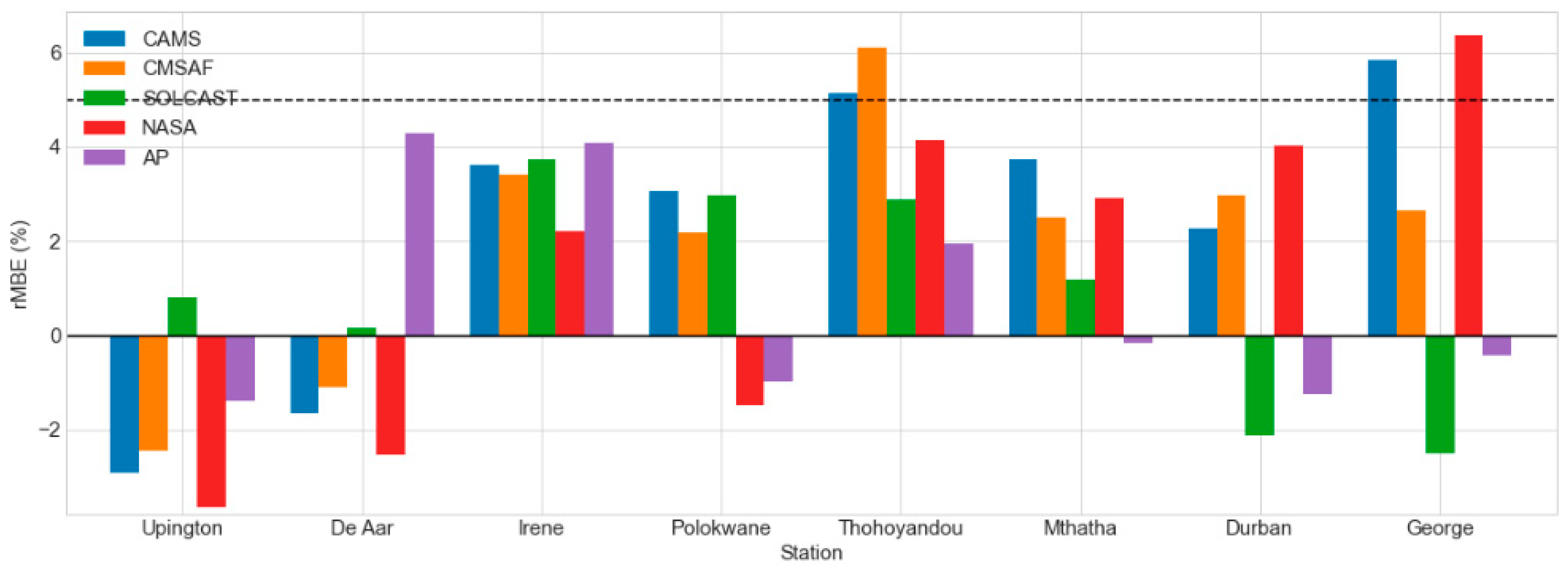
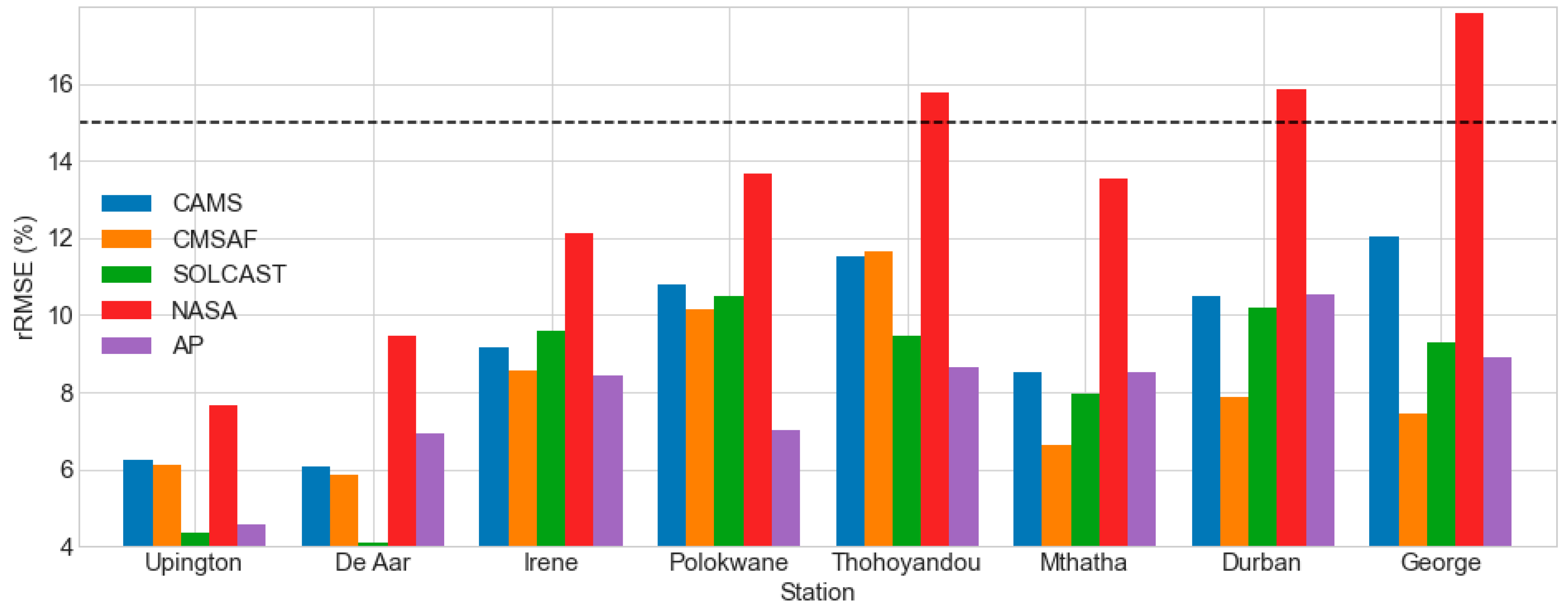
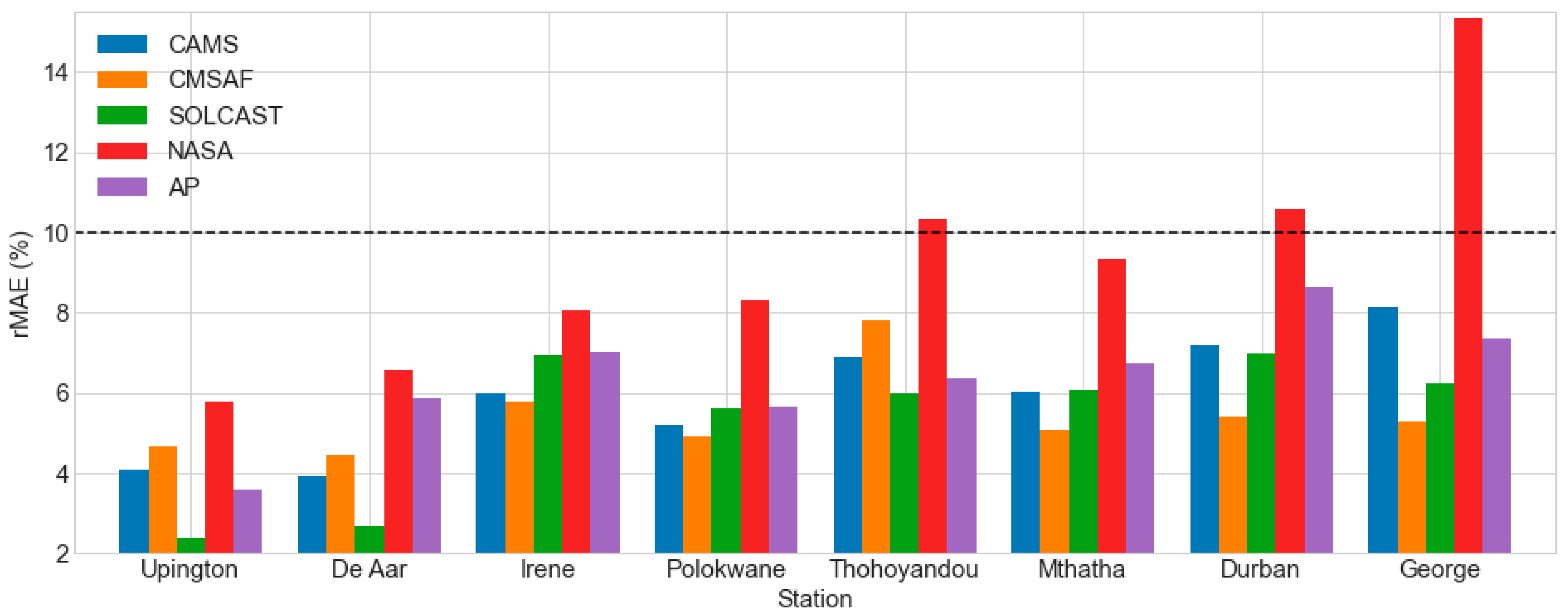
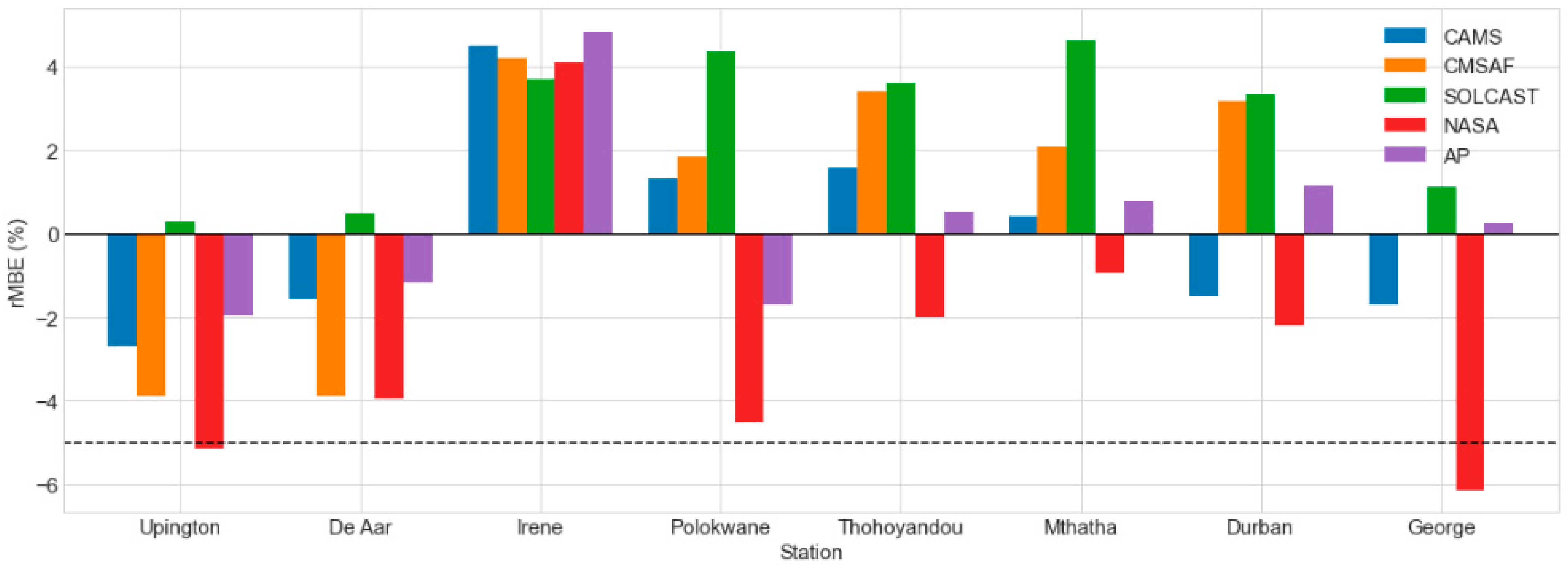
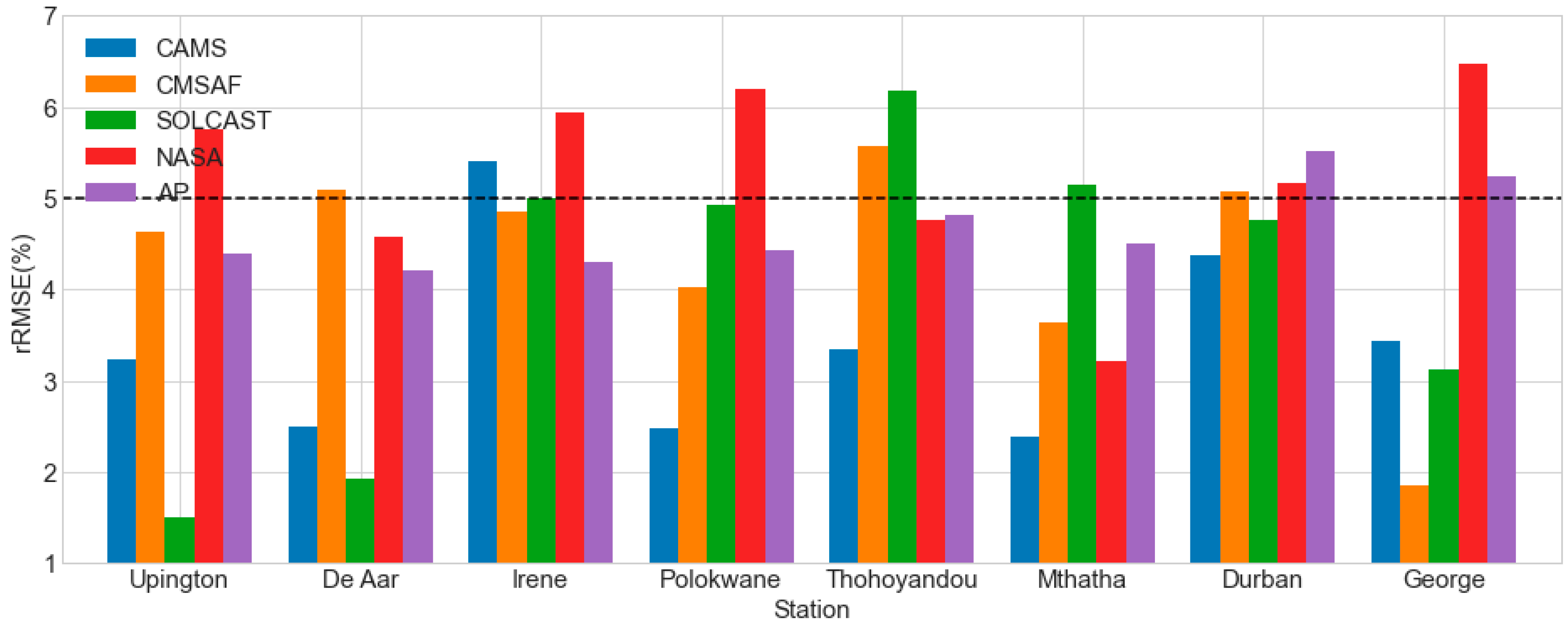
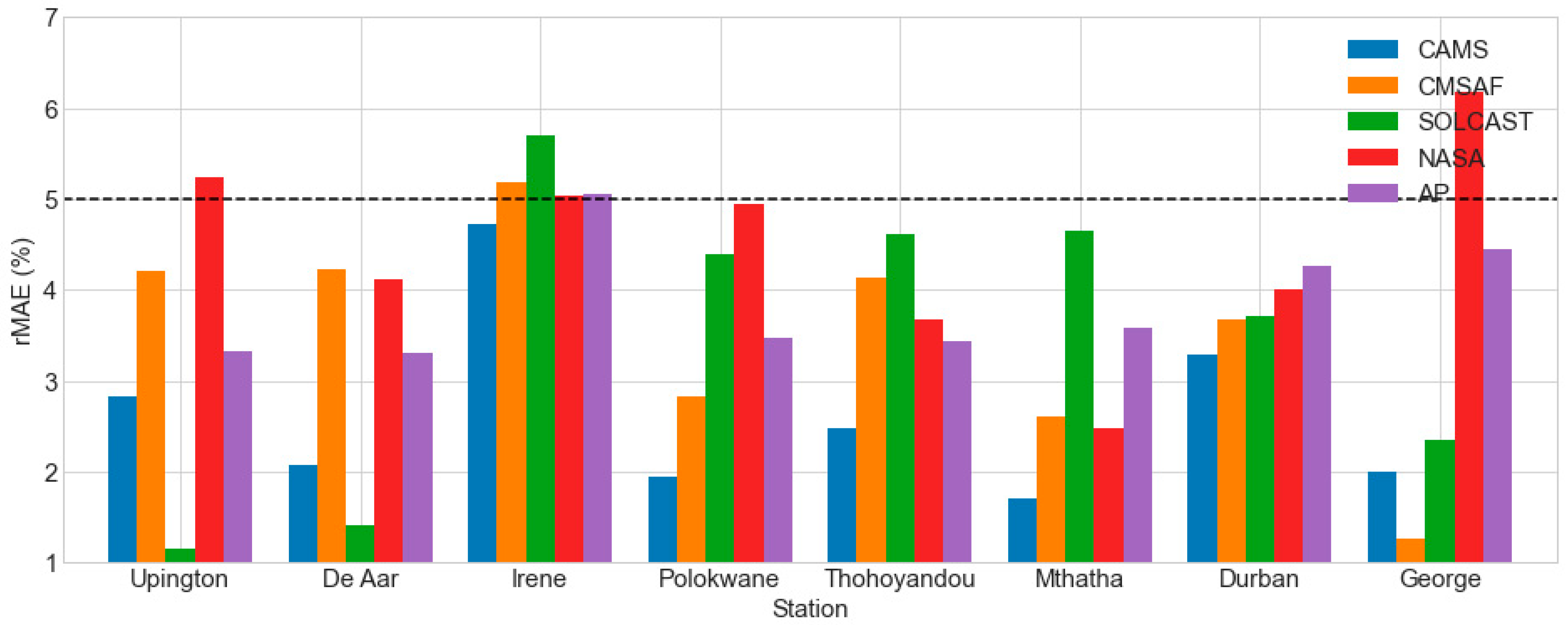
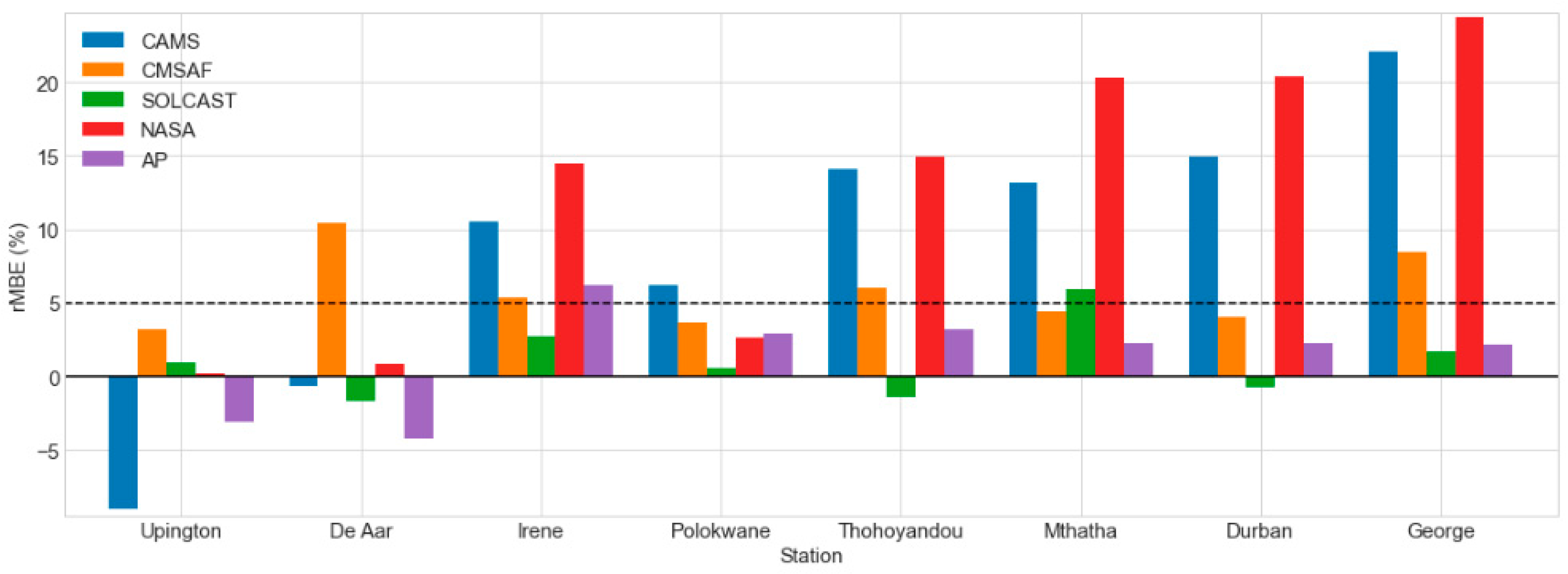
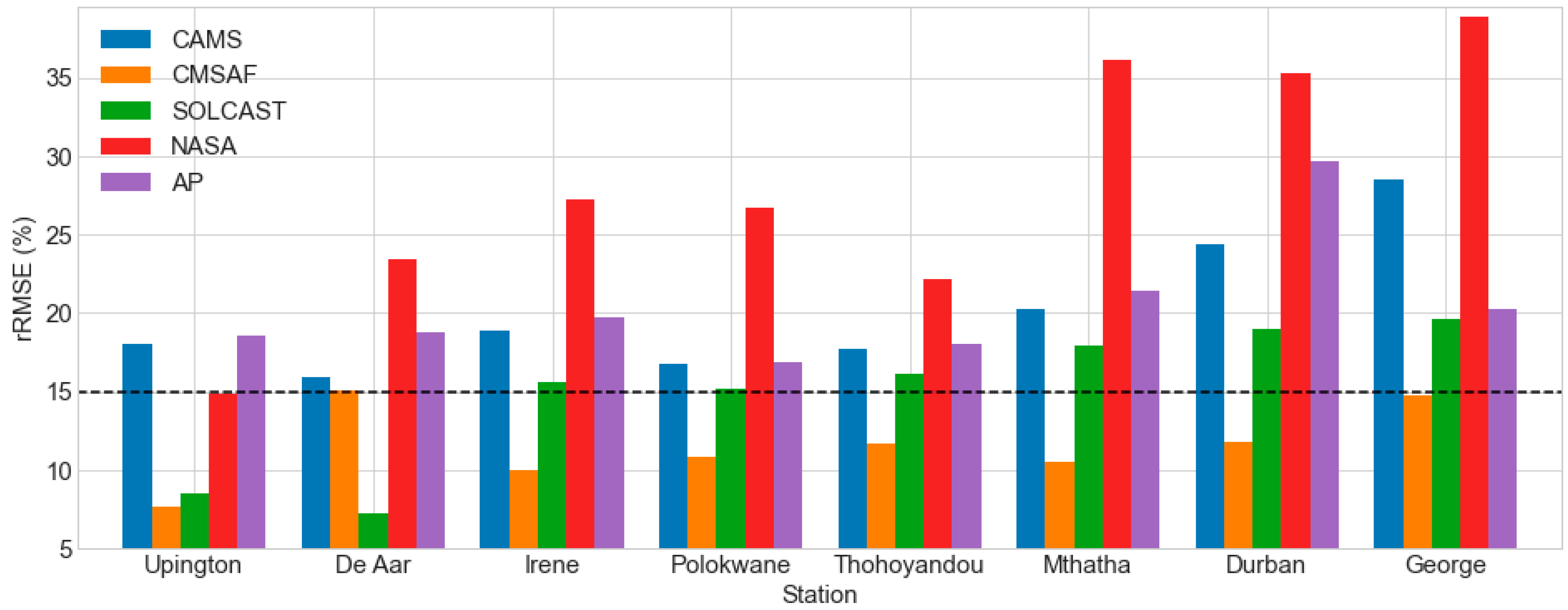
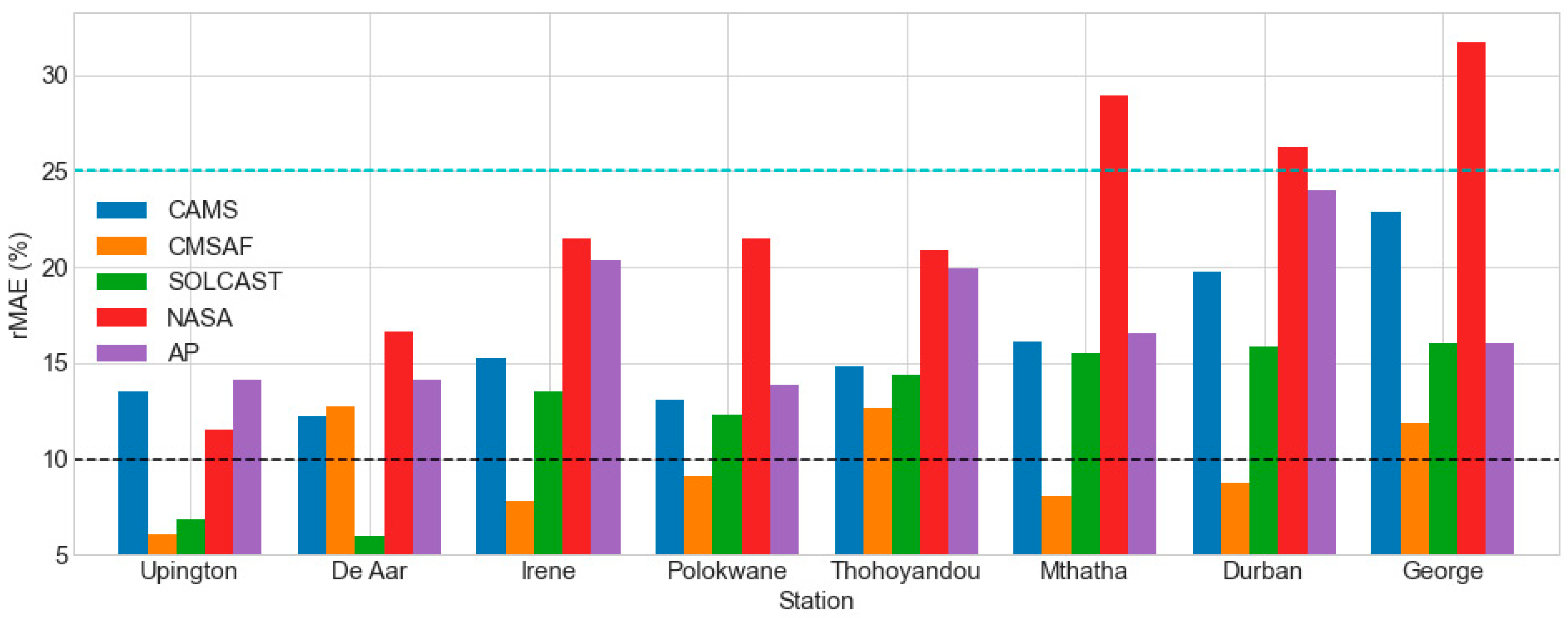
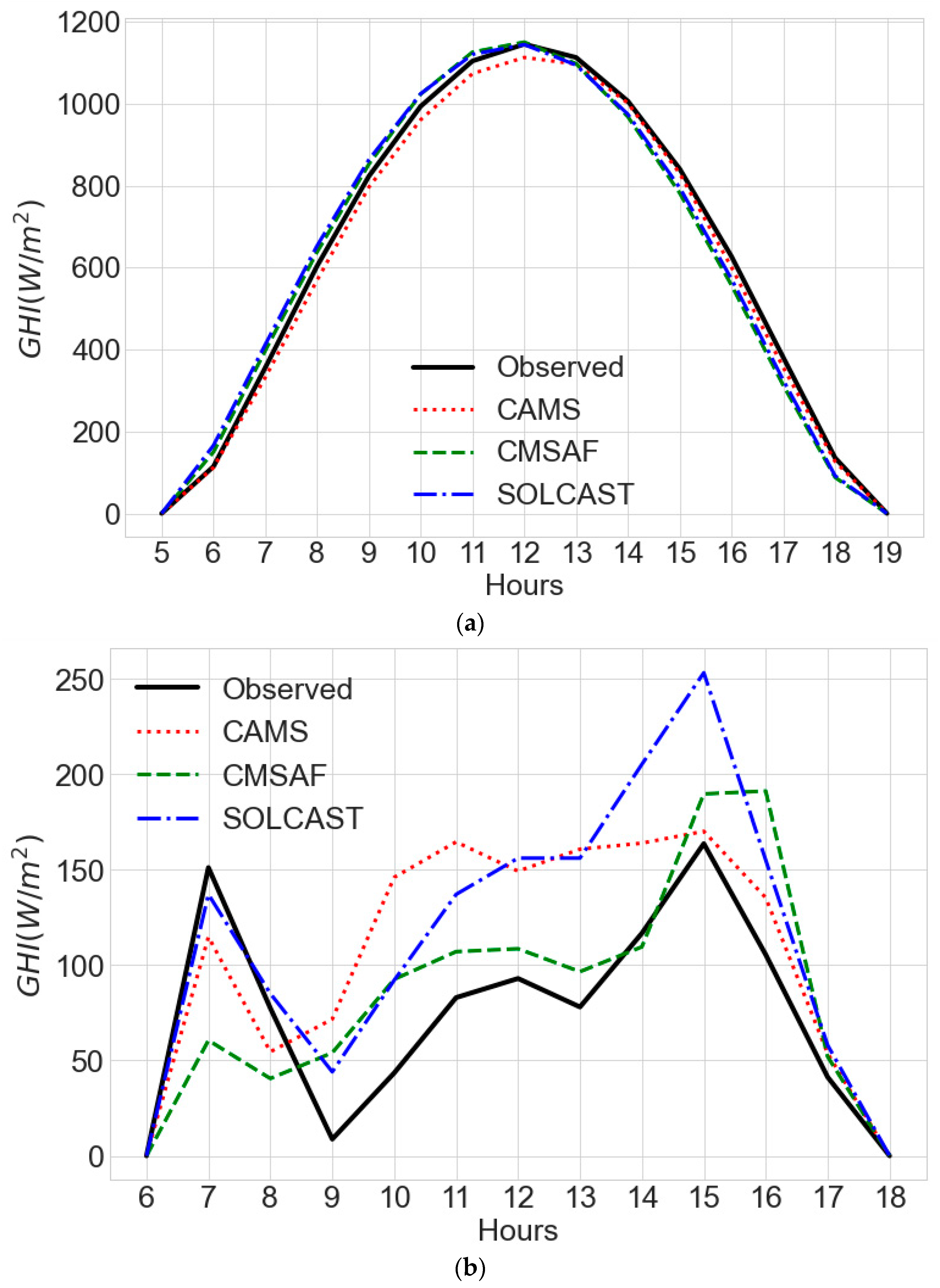
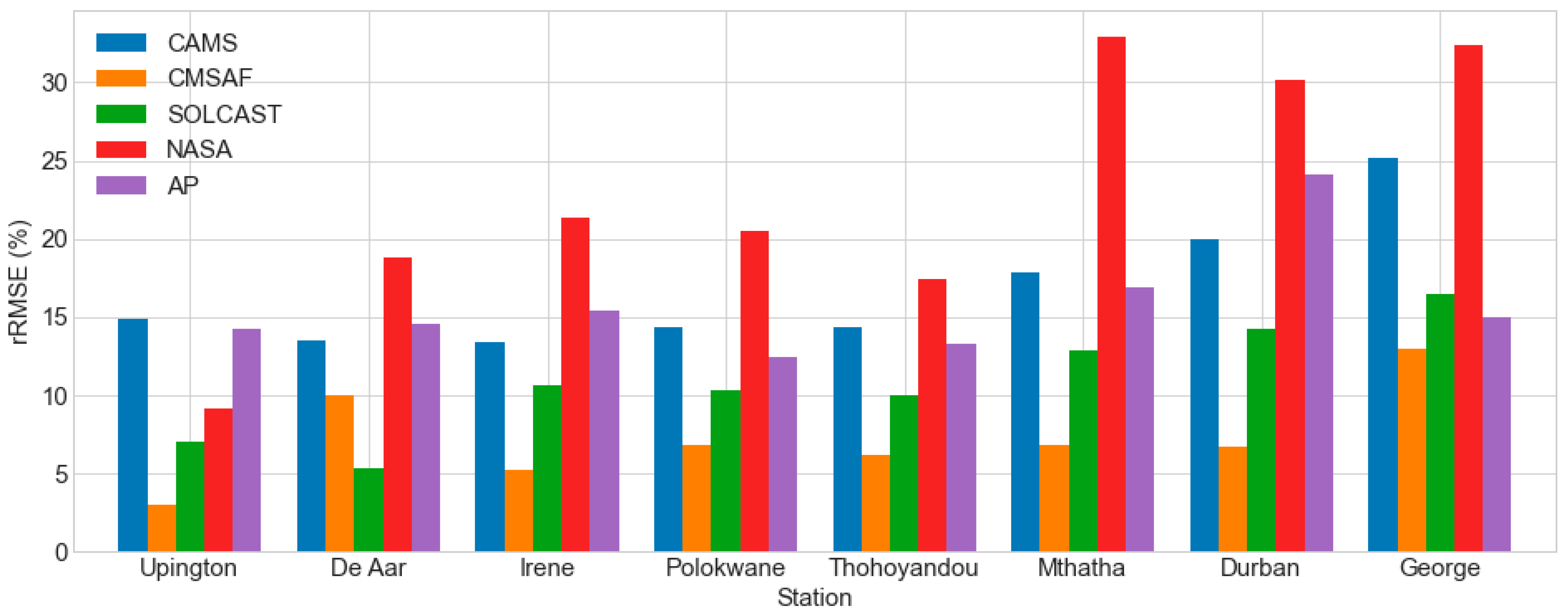
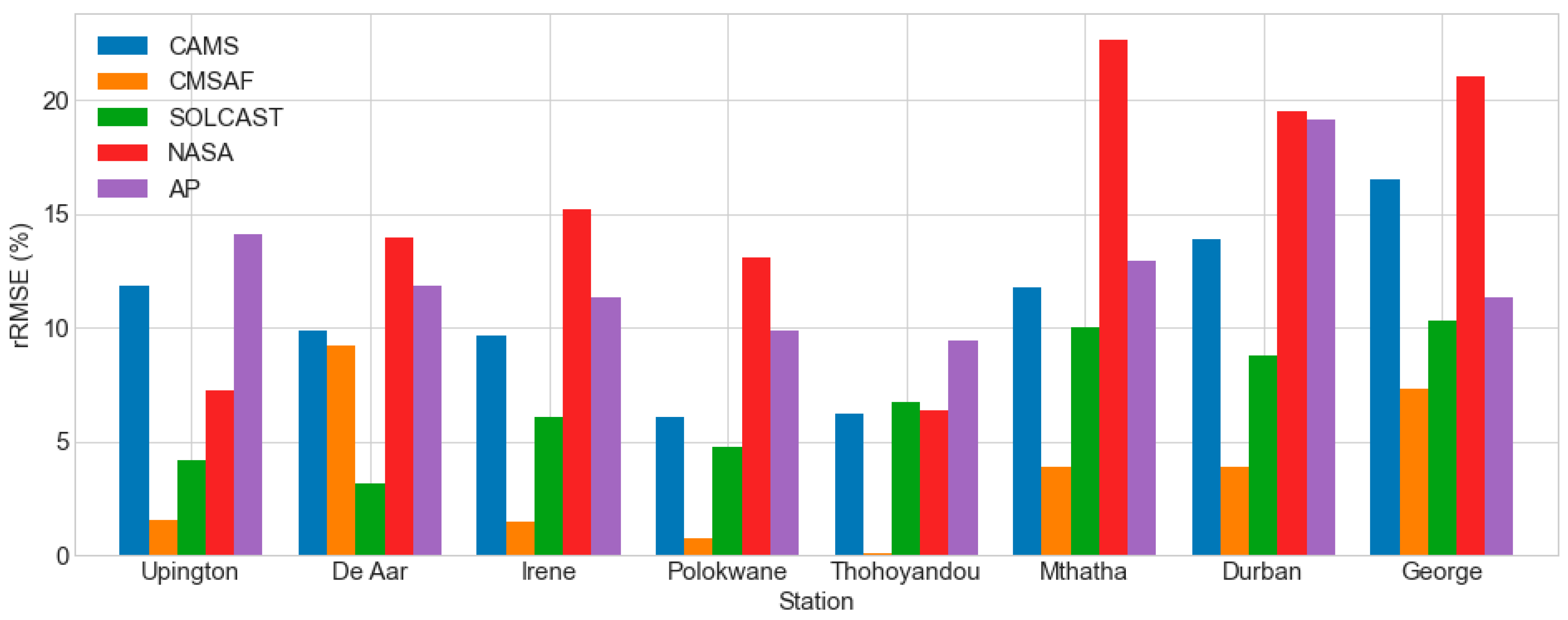

| Station | Latitude (°) | Longitude (°) | Altitude (m) | GHI Observation Period |
|---|---|---|---|---|
| Upington | −28.48 | 21.26 | 848 | 1 February 2014 to 30 November 2019 |
| DeAar | −30.67 | 23.99 | 1284 | 1 May 2014 to 31 December 2019 |
| Irene | −25.91 | 28.21 | 1524 | 1 March 2014 to 31 December 2019 |
| Polokwane | −23.86 | 29.45 | 1233 | 1 March 2015 to 31 December 2019 |
| Thohoyandou | −23.08 | 30.46 | 619 | 1 March 2015 to 31 October 2017 |
| Mthatha | −31.55 | 28.67 | 744 | 1 August 2014 to 31 December 2019 |
| Durban | −29.61 | 31.11 | 91 | 1 March 2015 to 31 December 2019 |
| George | −34.01 | 22.38 | 192 | 1 January 2015 to 31 December 2019 |
| Skill | rMBE | rRMSE | rMAE | R2 |
|---|---|---|---|---|
| Poor | ||||
| Good | ||||
| Excellent |
| Station | MEAN | CAMS | CMSAF | SOLCAST | NASA | Ångström–Prescott |
|---|---|---|---|---|---|---|
| Upington | 260.81 | 0.985 | 0.987 | 0.991 | 0.979 | 0.930 |
| DeAar | 246.15 | 0.988 | 0.990 | 0.994 | 0.972 | 0.930 |
| Irene | 230.79 | 0.964 | 0.968 | 0.961 | 0.925 | 0.912 |
| Polokwane | 230.30 | 0.944 | 0.948 | 0.948 | 0.900 | 0.91 |
| Thohoyandou | 200.19 | 0.967 | 0.968 | 0.975 | 0.926 | 0.937 |
| Mthatha | 193.86 | 0.985 | 0.990 | 0.984 | 0.953 | 0.951 |
| Durban | 184.77 | 0.977 | 0.987 | 0.976 | 0.943 | 0.915 |
| George | 193.87 | 0.977 | 0.990 | 0.983 | 0.896 | 0.948 |
| Daily | Minimum rMBE | Minimum rRMSE | Minimum rMAE | Maximum R2 | Most Feasible | Rating |
|---|---|---|---|---|---|---|
| Upington | SOLCAST | SOLCAST | SOLCAST | SOLCAST | SOLCAST | 4/4 |
| De Aar | SOLCAST | SOLCAST | SOLCAST | SOLCAST | SOLCAST | 4/4 |
| Irene | NASA SSE | AP | CMSAF | CMSAF | CMSAF | 2/4 |
| Polokwane | AP | AP | CMSAF | CMSAF | AP/CMSAF | 2/4 |
| Thohoyandou | AP | AP | SOLCAST | SOLCAST | AP/SOLCAST | 2/4 |
| Mthatha | AP | CMSAF | CMSAF | CMSAF | CMSAF | 3/4 |
| Durban | AP | CMSAF | CMSAF | CMSAF | CMSAF | 3/4 |
| George | AP | CMSAF | CMSAF | CMSAF | CMSAF | 3/4 |
| Station | MEAN | CAMS | CMSAF | SOLCAST | NASA | Ångström–Prescott |
|---|---|---|---|---|---|---|
| Upington | 276.47 | 0.998 | 0.997 | 0.999 | 0.997 | 0.994 |
| DeAar | 263.95 | 0.998 | 0.996 | 0.999 | 0.998 | 0.997 |
| Irene | 221.13 | 0.994 | 0.993 | 0.996 | 0.992 | 0.976 |
| Polokwane | 260.67 | 0.996 | 0.989 | 0.996 | 0.985 | 0.990 |
| Thohoyandou | 228.77 | 0.99 | 0.979 | 0.993 | 0.98 | 0.974 |
| Mthatha | 212.05 | 0.998 | 0.997 | 0.998 | 0.996 | 0.994 |
| Durban | 205.65 | 0.994 | 0.995 | 0.997 | 0.994 | 0.995 |
| George | 221.84 | 0.998 | 0.999 | 0.998 | 0.995 | 0.998 |
| Station | MEAN | CAMS | CMSAF | SOLCAST | NASA | Ångström–Prescott |
|---|---|---|---|---|---|---|
| Upington | 160.29 | 0.943 | 0.988 | 0.982 | 0.942 | 0.912 |
| DeAar | 143.83 | 0.908 | 0.959 | 0.983 | 0.802 | 0.878 |
| Irene | 137.53 | 0.935 | 0.981 | 0.936 | 0.863 | 0.871 |
| Polokwane | 139.51 | 0.907 | 0.962 | 0.913 | 0.737 | 0.896 |
| Thohoyandou | 121.55 | 0.929 | 0.942 | 0.957 | 0.835 | 0.812 |
| Mthatha | 110.28 | 0.944 | 0.979 | 0.934 | 0.823 | 0.894 |
| Durban | 99.9 | 0.923 | 0.976 | 0.925 | 0.854 | 0.847 |
| George | 107.72 | 0.936 | 0.968 | 0.918 | 0.748 | 0.908 |
| Dataset | rMBE | rRMSE | rMAE | R2 |
|---|---|---|---|---|
| SOLCAST | −2% to 4% | 4% to 10% | 2% to 7% | 0.948 to 0.995 |
| CAMS | −3% to 6% | 5% to 12% | 3% to 8% | 0.944 to 0.990 |
| CMSAF | −2% to 6% | 5% to 12% | 4% to 8% | 0.948 to 0.990 |
| Ångström–Prescott (AP) | −1% to 4% | 5% to 11% | 4% to 9% | 0.910 to 0.951 |
| NASA SSE | −4% to 6% | 8% to 18% | 5% to 15% | 0.896 to 0.979 |
Publisher’s Note: MDPI stays neutral with regard to jurisdictional claims in published maps and institutional affiliations. |
© 2022 by the authors. Licensee MDPI, Basel, Switzerland. This article is an open access article distributed under the terms and conditions of the Creative Commons Attribution (CC BY) license (https://creativecommons.org/licenses/by/4.0/).
Share and Cite
Mabasa, B.; Lysko, M.D.; Moloi, S.J. Comparison of Satellite-Based and Ångström–Prescott Estimated Global Horizontal Irradiance under Different Cloud Cover Conditions in South African Locations. Solar 2022, 2, 354-374. https://doi.org/10.3390/solar2030021
Mabasa B, Lysko MD, Moloi SJ. Comparison of Satellite-Based and Ångström–Prescott Estimated Global Horizontal Irradiance under Different Cloud Cover Conditions in South African Locations. Solar. 2022; 2(3):354-374. https://doi.org/10.3390/solar2030021
Chicago/Turabian StyleMabasa, Brighton, Meena D. Lysko, and Sabata J. Moloi. 2022. "Comparison of Satellite-Based and Ångström–Prescott Estimated Global Horizontal Irradiance under Different Cloud Cover Conditions in South African Locations" Solar 2, no. 3: 354-374. https://doi.org/10.3390/solar2030021
APA StyleMabasa, B., Lysko, M. D., & Moloi, S. J. (2022). Comparison of Satellite-Based and Ångström–Prescott Estimated Global Horizontal Irradiance under Different Cloud Cover Conditions in South African Locations. Solar, 2(3), 354-374. https://doi.org/10.3390/solar2030021







